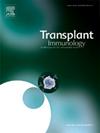IL-6 amplifies corneal transplant alloimmunity by inducing dysfunctional IFN-γ- secreting Treg through the VEGFA-VEGFR1 axis
IF 1.4
4区 医学
Q4 IMMUNOLOGY
引用次数: 0
Abstract
Background
Corneal allografts generally exhibit high acceptance due to the immune-privileged ocular microenvironment. Regulatory T cells (Treg) promote graft tolerance; however, in a vascularized milieu, they may acquire a pro-inflammatory phenotype. We investigated how dysfunctional Treg contribute to graft rejection through the VEGFA–VEGFR1 axis.
Methods
Treg were treated with IL-6 and VEGFA, and their phenotype—including FoxP3, IL-10, and IFN-γ—was evaluated with or without a VEGFR1 antagonist (αVEGFR1) using PCR, immunoblotting, ELISA, and flow cytometry. Suppressive function was assessed by T-cell proliferation assays, corneal cell death by Annexin V staining, and graft survival by adoptive transfer of dysfunctional Treg into a transplantation model.
Results
IL-6 reduced FoxP3 (p < 0.0001) and upregulated VEGFR1 (p < 0.001). IL-6 plus VEGFA further decreased FoxP3 (p < 0.0001) and IL-10 (p < 0.0001) while increasing IFN-γ (p < 0.0001). αVEGFR1 reversed these effects, restoring FoxP3 (p < 0.0001) and IL-10 (p < 0.05) while reducing IFN-γ (p < 0.001). Functionally, IL-6/VEGFA-pretreated Treg showed impaired suppression of effector T-cell proliferation (p < 0.0001), an effect partially rescued by αVEGFR1 (p < 0.001). In ex vivo assays, fresh Treg prevented, whereas dysfunctional IFN-γ–secreting Treg induced, corneal cell death (p < 0.0001). In vivo, grafts injected with dysfunctional Treg were rejected within 3–7 weeks, while those with αVEGFR1-treated Treg showed improved survival and reduced cell death (p < 0.0001).
Conclusion
IL-6 impairs Treg via VEGFR1 upregulation, driving IFN-γ secretion through the VEGFA–VEGFR1 axis and promoting corneal cell death and graft rejection.
IL-6通过VEGFA-VEGFR1轴诱导功能失调的IFN-γ分泌Treg,从而增强角膜移植异体免疫
背景:由于免疫优越的眼微环境,同种异体角膜移植通常表现出较高的接受度。调节性T细胞(Treg)促进移植物耐受;然而,在血管化的环境中,它们可能获得促炎表型。我们研究了功能失调的Treg如何通过vegf - vegfr1轴促进移植排斥。方法分别用IL-6和VEGFA处理streg,采用PCR、免疫印迹、ELISA和流式细胞术检测在加或不加VEGFR1拮抗剂(αVEGFR1)的情况下FoxP3、IL-10和IFN-γ的表型。通过t细胞增殖试验评估抑制功能,通过膜联蛋白V染色评估角膜细胞死亡,通过将功能失调的Treg过继转移到移植模型中评估移植物存活。结果sil -6降低FoxP3 (p < 0.0001),上调VEGFR1 (p < 0.001)。IL-6加VEGFA进一步降低FoxP3 (p < 0.0001)和IL-10 (p < 0.0001),同时增加IFN-γ (p < 0.0001)。αVEGFR1逆转了这些影响,恢复FoxP3 (p < 0.0001)和IL-10 (p < 0.05),同时降低IFN-γ (p < 0.001)。在功能上,IL-6/ vegfa预处理的Treg显示出对效应t细胞增殖的抑制受损(p < 0.0001), αVEGFR1部分恢复了这一作用(p < 0.001)。在离体实验中,新鲜Treg可预防角膜细胞死亡,而功能失调的IFN-γ分泌Treg则可诱导角膜细胞死亡(p < 0.0001)。在体内,注射功能失调Treg的移植物在3-7周内出现排斥反应,而注射α vegfr1处理的Treg的移植物存活率提高,细胞死亡减少(p < 0.0001)。结论il -6通过VEGFR1上调Treg,通过VEGFA-VEGFR1轴驱动IFN-γ分泌,促进角膜细胞死亡和移植排斥反应。
本文章由计算机程序翻译,如有差异,请以英文原文为准。
求助全文
约1分钟内获得全文
求助全文
来源期刊

Transplant immunology
医学-免疫学
CiteScore
2.10
自引率
13.30%
发文量
198
审稿时长
48 days
期刊介绍:
Transplant Immunology will publish up-to-date information on all aspects of the broad field it encompasses. The journal will be directed at (basic) scientists, tissue typers, transplant physicians and surgeons, and research and data on all immunological aspects of organ-, tissue- and (haematopoietic) stem cell transplantation are of potential interest to the readers of Transplant Immunology. Original papers, Review articles and Hypotheses will be considered for publication and submitted manuscripts will be rapidly peer-reviewed and published. They will be judged on the basis of scientific merit, originality, timeliness and quality.
 求助内容:
求助内容: 应助结果提醒方式:
应助结果提醒方式:


